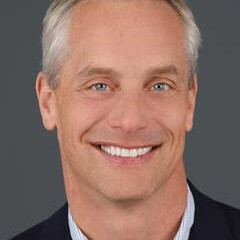It was a warm Saturday in mid-June when Steve noticed that something was “off.” As an avid athlete, he’d spent years participating in triathlons – multisport races that incorporate biking, swimming, and running. After several years of racing, he qualified for the World Triathlon Championships and spent nearly a year training for the big event.
“I was using races to improve my fitness because you never work as hard in training as you do in a race. So, I did a lot of races. In the span of three weekends, I think I did six races of different kinds, all involving running, biking, and swimming. I had a Sunday race, so I spent this particular Saturday going through my normal ‘day-before-a-race’ routine. I did a 20-mile bike ride and felt a little sluggish but didn’t think much of it at first. I returned from my bike ride and immediately changed into my sneakers for a four-mile run,” Steve recalls.
As soon as he jogged out of his driveway, he experienced a pain in his ribs so intense that he had to stop. “I walked a little bit and tried running again, but the pain was awful. Something was definitely off, but I rested and ended up doing the race the next day. I didn’t perform well, to no one’s surprise.”
Steve continued training for the Championships but started experiencing some breathing issues. “It seemed like I’d inflate my lungs to a certain point when I was at peak exertion, but then there was a line I couldn’t cross – if I crossed a line, I experienced meaningful pain.”
Steve contacted both his primary care doctor and a cardiologist and had a chest x-ray and echocardiogram. (Also known as an echo, an echocardiogram uses ultrasound waves to look at the heart’s chambers and valves and to assess how blood is moving through the heart.) Steve’s tests didn’t identify anything out of the ordinary.
The following week, Steve went out for a trail run and vividly remembers feeling like he was at high altitude. A few days later, he found himself stopping three times while running on a familiar route. “I just wasn’t feeling like myself, but I kept running because that’s what I love to do.”
My mind went from blood clots to stroke to ‘I’m dying and won’t see my kids again.’ That was emotionally very difficult.
On the heels of these episodes, Steve saw a pulmonologist and had some more testing done, including a CT scan with contrast. (CT scans provide a detailed view of the organs and blood vessels, and contrast refers to a dye that’s used to highlight the specific areas of the body that are being evaluated.)
“Shortly after the scan, I was told ‘your pulmonary arteries are about 90% blocked and you have blood clots throughout your lungs. We’re taking you to the emergency room.’ My mind went from blood clots to stroke to ‘I’m dying and won’t see my kids again.’ That was emotionally very difficult. It was also hard to wrap my head around the fact that I was feeling fine if I wasn’t exercising or trying to breathe deeply. Day to day, I felt fine – but there was this silent thing in me that was potentially deadly. It was tough to process that.”
Steve also didn’t know why his PE happened. “I started educating myself about the risk factors for blood clots, but nothing really checked out for me. I wasn’t dehydrated, I wasn’t a smoker, I didn’t take steroids, I hadn’t returned from a long trip on an airplane…my best guess is that I pushed my body to extreme levels. I sort of turn myself inside out when I race; perhaps I created some sort of perfect storm that then caused my PE.”
Steve spent two nights in the hospital and was discharged with a prescription for warfarin, a blood thinner used to prevent new blood clots from forming. “Within a few days, I was able to go for a walk, but I had to drop out of the World Championships. There was just no way that being on a blood thinner, I could risk a bike crash.”
“Be honest with your doctors…and with yourself. I’d suggest that people take a step back and evaluate why they’re doing what they’re doing. If it’s costing you your health, is it worth it?”
But what Steve remembers even more than the disappointment of having to withdraw from the Championships is the anxiety around his diagnosis. “It was very real for a long time,” he says. “June 25th was the day I saw the pulmonologist for the first time…and for years after my PE, I had chest pain on June 25th. I gradually built up my exercise and was able to return to my normal level of activity, but the anxiety took a while to get past. That said, the experience wasn’t all bad – it led to a lot of self-reflection, and I made a few changes in life because of it.”
And for fellow athletes who may experience a health setback, Steve offers these words of wisdom: “Be honest with your doctors…and with yourself. Think about why you’re pushing yourself so hard in the first place. A lot of us in the racing world are totally obsessed with activity and competition, but is it that important? There’s an exercise I’ve heard about where you write your own obituary or what’s on your tombstone. Do I want ‘triathlete’ to be on my tombstone? No, I don’t. So why turn myself inside out for a sport? I’m proud of what I’ve done but I’d suggest that people take a step back and evaluate why they’re doing what they’re doing. If it’s costing you your health, is it worth it? I’m not so sure it is.”
Every patient has a story and NATF invites you to share yours! If you’d like to submit a patient story, please contact us at [email protected].
